Contents
- 1. Stage of the retired householder (vanaprasthashram)
- 2. Stage of the renunciant (sannyasashram)
- 2.1 Origin and meaning
- 2.2 Yati – A synonym for a renunciant
- 2.3 History of the concept of a renunciant
- 2.4 Objectives and importance
- 2.5 Sacrifice and renunciation
- 2.6 When should one renounce the world?
- 2.7 Types of renunciation
- 2.8 Taking permission to become a renunciant
- 2.9 The ritual of acceptance of renunciation (sannyasgrahan)
- 2.10 A type of renunciants – Dasnami
- 2.11 The mental attitude of a renunciant
- 2.12 The code of conduct and spiritual practice of a renunciant
- 2.13 The stage of renunciation and the class (varna)
- 2.14 The last rites of a renunciant
- 3. The yugs and the stages of life
- 4. Comparison between different stages of life
1. Stage of the retired householder (vanaprasthashram)
1.1 Meaning
‘गृहस्थाश्रममपहाय गृहीतमुनिवृत्तिरसंन्यस्त: ।’ (L.S.), means the stage of the retired householder is one in which one retires to the forest sacrificing one’s home but without becoming a renunciant (sannyasi).
1.2 Importance
A. An individual learns to live in a larger family in a hermitage (ashram) instead of a smaller one.
B. Death is the eternal truth. Each one has to ultimately die. Death means departing with the subtle body leaving the physical body and belongings on the earth. The objective of this stage of the retired householder in which one surrenders everything and lives in a hermitage in a forest is to prepare for this so that one does not grieve at that final moment.
1.3 When should one accept this stage?
After bearing a son which is the very objective of the stage of the householder one may adopt this stage of life. Some people adopt the stage of the retired householder after their son bears a son. Generally it is supposed to be adopted between the age of 50-75 years. However if one has already developed intense detachment (vairagya) then the scriptures permit one to go directly from the stage of a celibate to that of a retired householder without spending 25 years in the stage of the householder. If one’s wife is unprepared to accompany one in the stage of the retired householder then the son should be asked to look after her.
1.4 Duties and spiritual practice
Spiritual practice in the stage of the retired householder is undertaken with the objectives of purifying the physical body and undertaking the study of the scriptures.
नानशनात् परं तप: ।
Meaning: (For the retired householder) no spiritual practice is greater than observing a fast.
‘In the stage of the retired householder one is supposed to sacrifice physical pleasures and contemplate on philosophical concepts. Hence such an individual should endure the fire, sun and rain, grow a beard and a moustache, have matted hair, not cut his nails, usually observe silence (maun), study the Aranyaks and Upanishads so as to acquire spiritual knowledge and even become the disciple of a Self-realised sage so as to be able to get all his doubts about Spirituality clarified.
During the Vedic period some sages would lead a life of penance away from human habitation. They were not interested in sacrificial fires useful for the householder and in worldly riches. It is these sages who have written the Aranyaks from Vedic literature. Only those living in the forest were eligible to study them, not those residing in towns or cities. These people who had great faith in God and performed austerities in the forest were learned individuals.
For most, the stage of the retired householder was akin to that of the celibate. The attitude of penance and spiritual practice of the Path of Knowledge of a celibate became consolidated in this stage and took one to the ultimate goal of one’s life.’ (1)
1.5 Livelihood
Sustaining oneself on fruits and tubers from fallow land.
1.6 The stage of the retired householder and the classes
Mostly Brahmans and Kshatriyas adopted this stage of the retired householder.
1.7 Decline in the stage of the retired householder
Due to changes according to the influence of time nowadays this stage of the retired householder has virtually reached extinction. It is noteworthy that an old age home (vruddhashram) is not equivalent to this stage.
2. Stage of the renunciant (sannyasashram)
2.1 Origin and meaning
The word sannyas (संन्यास) has been derived from the two words san (सं) [meaning all] and nyas (न्यास) [meaning to give up, sacrifice]; hence it means sacrifice of everything.
काम्यानां कर्मणां न्यासं संन्यासं कवयो विदु: ।। – श्रीमद्भगवद्गीता १८.२
Meaning: The learned say that sacrifice of actions done with expectation itself is renunciation (sannyas). – Shrimadbhagvadgita 18.2
2.2 Yati – A synonym for a renunciant
‘यतते चेष्टते मोक्षार्थमिति’ means that a yati is defined as one who makes efforts to attain the Final Liberation (Moksha). During the Vedic period people who wore blood red clothing, begged and lived only on alms (bhiksha) as a means of sustenance, constantly travelled without a permanent abode and were completely detached were called yatis.’ (2)
2.3 History of the concept of a renunciant
‘The words retired householder (vanaprastha) and renunciation (sannyas) are not found in the Vedas but the word yati which appears to be a synonym of sannyasi (renunciant) appears in them. However satirically yati means a magician. The Vedic words yati and yatu (magic) have a common root, yat. Yatis in the Vedic context are magicians who perform yatu that is magic. Nevertheless sages whose apparel is air (vayu) are mentioned in the Rugveda (10.136.2) but They cannot be said to belong to the fourth stage (ashram) of life. From this it appears that the stages of the retired householder and the renunciant must have not been established during the period of the Sanhitas. They began later during the period of the Upanishads when followers of the Vedas lost their faith in sacrificial fires (yadnyayag) and ritualistic worship (karmakand) and developed faith in knowledge and detachment. It is from this revolution in thinking that the stage of the renunciant originated. The Upanishads include concepts of all the four stages but without explicitly using such terminology. The story of Yadnyavalkya and Maitreyi appears in the Bruhadaranyak. There Yadnyavalkya says, “O Maitreyi, I will now leave home and renounce the world (pravrajya) (4.5.2)”. Pravrajya is a substitute word for sannyas. It also appears in Buddhist literature. The Jabalopanishad extensively deals with the concept of renunciation (sannyas). Till the period of the Mundakopanishad the concept of the four stages had become deeply rooted with the renunciant gaining predominance. By the period of Panini the institution of renunciation (parivrajak) became established. To spread the code of conduct of a renunciant, aphorisms (sutras) for renunciants were also created. Later the scriptures too incorporated the stage of the renunciant along with the other three stages.’ (3)
2.4 Objectives and importance
In the stage of the retired householder as one lives in only one place, even though it is a forest there is a chance of developing attachment for that place. To avoid generation of such attachment a renunciant does not stay in one place for more than three days. A quote from the Yogavasishtha (7.67.29) given below explains the importance of avoiding being in constant contact.
अबन्धुर्बन्धुतामेति नैकट्याभ्यासयोगत: ।
यात्यनभ्यासतो दूरात्स्नेहो बन्धुषु तानवम् ।। – योगवासिष्ठ ७.६७.२९Meaning: Constant contact makes even a stranger seem like a relative and separation decreases the affection for even one’s own brother making him seem like a stranger.
‘In this stage man acquires a chance to become independent and thus he becomes spiritually oriented. So long as he is bound by a specific place, family, village, country, lineage, code of Righteousness (Dharma), profession and position his intellect and thoughts also remain limited. After adopting renunciation he has to transcend all such barriers and go beyond them.’ (4)
2.5 Sacrifice and renunciation
काम्यानां कर्मणां न्यासं संन्यासं कवयो विदु: ।
सर्वकर्मफलत्यागं प्राहुस्त्यागं विचक्षणा: ।। – महाभारत ६.४२.२Meaning: (Lord Shrikrushna says) Learned men refer to sacrifice of actions done with expectation as renunciation and wise men refer to sacrifice of the results of all actions that is of the desire for results of action itself as tyag (sacrifice). – Mahabharat 6.42.2
2.6 When should one renounce the world?
A. One should renounce the world after completion of the three stages of life
विनेषु च विहृत्यैवं तृतीयं भागमायुष: ।
चतुर्थमायुषो भागं त्यक्त्वा सङ्गान्परिव्रजेत् ।। – मनुस्मृति ६.३३Meaning: After spending the third phase of one’s life in the forest (as a retired householder) one should surrender everything in the fourth phase and renounce the world. – Manusmruti 6.33
B. ‘यदहरेव विरजेत् तदहरेव प्रव्रजेत्’ means one should embrace renunciation the day one develops detachment irrespective of the stage in which one is currently.
2.7 Types of renunciation
A. Vividisha: This is renunciation undertaken with the desire for Self-realisation and is done with a ritual.
B. Atur: This is renunciation taken suddenly after the realisation that one is at the fag end of one’s life dawns upon oneself. This is done without any ritual.
C. Tridandi: ‘This is called so because these renunciants wield three (tri) staffs (danda) tied together in the right hand. These three staffs signify the control over the mind, speech and body. A verse (shloka) from the Manusmruti says –
वाग्दण्डोऽथ मनोदण्ड: कायदण्डस्तथैव च ।
यस्यैते निहिता बुद्धौ त्रिदण्डीति स उच्यते ।। – मनुस्मृति १२.१०Meaning: The one who has kept the three restraints over speech, mind and body under the control of the intellect is said to be the one wielding the three staffs (tridandi). – Manusmruti 12.10
This is considered as an inferior type of renunciation. It is believed that such a renunciant does not have to give up tying of a tuft of his hair in a ponytail (shikha), his sacred thread and loin cloth and can also return to the stage of a householder whenever he so desires. The Mahabharat narrates a story in which before abducting Subhadra, Arjun had been living in Dvarka for four months as such a renunciant’ (5)
The one returning to the stage of a householder from the stage of a renunciant has to perform acts of penitence (kruchchra) for six months and has to bathe with clothes on to overcome impure touch (Gautam Dharmasutra 14.28). He also has to perform the acts of penitence if he has become unrighteous.
One cannot return to the stage of the householder once the stage of the renunciant is adopted except in the case of the tridandi renunciation (sannyas).
2.8 Taking permission to become a renunciant
A celibate has to take his mother’s permission to become a renunciant as after the death of his father he is her caretaker. Even the great saint Shri Shankaracharya became an ascetic after seeking permission from His mother. If a householder wishes to become a renunciant then he has to obtain permission from his wife as otherwise her marital life will be disrupted, that is in other words she too will become a renunciant.
2.9 The ritual of acceptance of renunciation (sannyasgrahan)
‘The sun’s sojourn in the northern hemisphere from the equator to the Tropic of Capricorn is ideal for this ritual. The sun’s southward progress too is favourable for one who is on the verge of death (atur). Those desirous of taking renunciation should study the code of conduct of a renunciant by living with the Guru for some days. Then purifying the body by chanting the Gayatri mantra, chanting the Name of Lord Rudra, performing the Kushmand fire sacrifice (hom), etc. on the fourth, ninth or fourteenth day in the bright fortnight (rikta tithi) one should give offerings after remembering the time and place to acquire authority. Eight rituals of shraddhas (rite for departed souls) should be performed. Before accepting the stage of the renunciant to avoid the problem of who will perform the shraddha after one’s death as all ties including those with one’s son and relatives are severed by becoming a renunciant, one should perform a shraddha for oneself. The following day leaving behind only six hairs one should shave off the scalp hair. After a bath one’s remaining wealth, etc. should be given to Brahmans and one’s own sons. The loin cloth (langoti), the saffron robes of a renunciant (chati), etc. should be dyed with the extract of red orchid. A bamboo staff should be procured from a Brahman. A quilt and wooden footwear (paduka) should also be arranged for. Then the resolve for the ritual of accepting renunciation should be uttered. Ritualistic worship of Lord Ganapati and the Matrukas, the rite of Punyahavachan and the ritual of Nandishraddha should be performed.
When leaving home the sons and others should be blessed thus –
सर्वे भवन्तु वेदाढ्या: सर्वे भवन्तु सोमपा: ।
सर्वे पुत्रमुखं दृष्ट्वा सर्वे भवन्तु भिक्षुका: ।।Meaning: May all become well versed in the Vedas. May all be worthy of drinking som (divine wine) in sacrificial fires. May all become renunciants after bearing sons.
At the end of the ritual one should bid farwell to one’s sons and relatives telling them “न मे कश्चित् नाहं कस्यचित्” meaning I belong to no one and no one belongs to me. Then one should go to a water reservoir and offer three palmfuls of water into it.
Chanting the verse given below once again one should release a palmful of water into the water reservoir.
पुत्रैषणा वित्तैषणा लोकैषणा सर्वैषणा मया परित्यक्ता ।
अभयं सर्व भूतेभ्यो मत्त: स्वाहा ।।Meaning: I have given up all desires for sons, wealth, success, fame and all other things. Now all the living beings need not harbour any fear from me.
Facing the east one should stand in water reaching the level of the umbilicus and recite the aphorism (sukta) “Taratsamandi… (तरत्समन्दी०)”. Then making a resolve that “from now on I who have been released from the attachment for my sons and for receiving recognition from others will survive only on alms” once again one should release a palmful of water into the water reservoir. Plucking out the tuft of hair (shikha), along with the sacred thread one should immerse them in the water after which a prayer unto Lord Vishnu should be made. After undressing completely one should take five steps facing the north. Thereafter one should wear the loin cloth (kaupin) and clothes and holding a staff, a water pot and a seat in the hand should surrender unto the Guru. Holding the Guru’s lotus feet one should plead before Him to impart knowledge of Brahman. The Guru fills a conch with water and consecrating it with Om sprinkles (abhishek) the disciple with it. He first recites the Shantipath and places His hand on the disciple’s head and then recites the Purushsukta. Placing His hand on the disciple’s heart the Guru whispers a great quote like “You are Brahman (तत्त्वमसि)”, etc. in his right ear and explains its meaning to him. Thereafter He names the disciple according to the sect. Some title such as tirtha, ashram, etc. may be suffixed to his name.
After that on some auspicious day a householder should invite the renunciant and offering a seat opposite himself should bathe his feet with earth and water. The renunciant should then purify his loins and wear a cord (kargota) around the loins and a loin cloth (kaupin). He should then drape his waist with a cloth. Thereafter the renunciant (yati) should pay obeisance to the senior renunciants and householders should offer him obeisance after which the yati should bless the former with the blessing “Narayan”.’ (6)
2.10 A type of renunciants – Dasnami
‘This is a sect of the Shaiva Gosavis. They generally remain naked and hence are also called Naga sadhus (ascetics). Every category of the Dasnami renunciants is subdivided into four classes viz. Kutichak, Bahudak, Hansa and Paramhansa depending upon their spiritual level.(7)
‘A. Kutichak: He is the one who resides in a hut built by his son and wields the three staffs (tridand), a water pot (kamandalu), a tuft of hair (shikha) and a sacred thread (janave). He survives on alms from his sons and relatives.
B. Bahudak: He dons saffron robes, wields three staffs and a water pot. He is supposed to beg for alms only in seven households. He should refrain from eating meat, salt and stale food.
C. Hansa: He spends one night in the village and five nights in the city. He begs for alms for eleven months and starves for one month of the year.
D. Paramhansa: He lives beneath a tree, in a deserted house or a crematorium. He either wears only one garment or remains nude. He is not bound by the restrictions of Righteousness (Dharma) and action (karma). He can beg for alms from anyone. He is free of duality, views everything with equanimity and is the all pervading soul. His external appearance gives the impression that he is insane.
These four types are progressively of a superior degree. A renunciant is fearless and offers protection.’ (8) ‘The organisation of the Dasnami Naga renunciants is called akhada. All the Dasnami renunciants are incorporated in the seven akhadas of nirvani, niranjani, juna, atal, avahan, agni and anand. The style of tying the matted hair and the headgear (pagadi) of followers of different akhadas is different. The chief of an akhada is called a mahant. Each akhada is further subdivided into fifty-two parts each of which is called a madhi. There is another division of the akhada known as dava. Thus in all there are eight davas in which are included fifty-two madhis. They are called ramadatti, ruddhinathi, charmadhi, dasmadhi, etc. The davas with names of puri are four in number and include the ascetics bharati, sarasvati, tirtha, ashram, vana and aranya. They are named Vaikunthi, Sahajavat, Dariyan and Bharati.’(9)
E. Types according to the hermitage (akhada) and special feature: Based on the Bharatiya Sanskrutikosh they are as given in the table below
| Name | Number | Main centre |
Other centres | Benevolent deities (ishtadev) |
Special features |
| 1. Nirvani | 500 | Prayag | Kanakhal, Omkar, Kashi, Tryambak, Kurukshetra, Ujjain, Udaipur, Akola, Jvalamukhi |
Kapil | – |
| 2. Niran- jani |
500 | Prayag | Haridvar, Kashi, Tryambak, Omkar, Ujjain |
Kartikeya | – |
| 3. Juna | 300 | Kashi | Prayag, Haridvar, Omkar, Tryambak, Ujjain |
Dattatreya | Organisation of female renunciants |
| 4. Atal | 100 | Kashi | Vadodara, Haridvar, Tryambak, Ujjain |
Ganesh | – |
| 5. Avahan | 100 | Kashi | – | Dattatreya and Gajanan |
Associated with the Niranjani group |
| 6. Agni | – | Kashi | – | Agni (the deity of fire) |
Presently renunciants of all four seats (piths) reside here |
| 7. Anand | Very few |
– | – | Surya (the Sun deity) |
Nearly extinct |
‘In North India there is a traditional belief as to why the Naga renunciants adopted the fighting attitude instead of undertaking chanting and penance. It goes thus – in the second half of the 16th century A.D. Madhusudan Sarasvati of Varanasi first formed a regiment of warrior Nagas. During those days Muslim mendicants wielded weapons and would time and again slay Hindu renunciants. To overcome this calamity Madhusudan Sarasvati taught the Nagas to take up arms and along with the Brahmans (priests), Kshatriyas (warriors) and Vaishyas (businessmen) also permitted Shudras (labourers) into the fold of the akhada.
Though initially the Naga renunciants wielded weapons in self-defence to protect themselves from Muslims later they did not hesitate to do the same against Hindus in connivance with soldiers from the Muslim Nawabs’ armies. In the battle between renunciants (sannyasis) and mendicants (bairagis) which occurred in Haridvar in 1760 A.D. approximately eighteen thousand Nagas were killed. An account of the Nagas participation in the royal battles of the Marathas, Rajputs and Sikhs on several occasions is also available.
The Naga ascetics believe in rigorous physical discipline. They observe various modes of physical penance such as standing with arms raised, standing on one foot, sleeping on a bed of nails, the spiritual practice of five fires (panchagnisadhan), etc. because they consider that this facilitates the attainment of the Final Liberation (Moksha). Since Shudras were also allowed into the hermitage (akhada) they must have found austerities inflicting physical hardships easier in comparison to the study of scriptures. But due to lack of study of the scriptures later they began to find it difficult to resist the Christian missionaries. Since they did not know Indian philosophies they could not defeat the Christian missionaries in debates. It was then to improve the situation that leaders of the Dasnami Nagas requested the learned Paramhansas to teach them Spirituality and the other sciences. The Paramhansas then began teaching them. Each Paramhansa teacher was accorded the title of mandaleshvar. A separate mandaleshvar was appointed for each akhada. In this process some Naga ascetics acquired spiritual knowledge and became mandaleshvars themselves. A mandaleshvar whose disciple also became a mandaleshvar during His lifetime was accorded the title of maha (the great) mandaleshvar.
Ascetics living in the akhada spend the day performing ritualistic worship of benevolent deities, chanting The Lord’s Name, studying the scriptures and in physical exercise. Formerly these ascetics indulged in a tremendous intake of intoxicating substances such as liquor, opium, cannabis (ganja or bhang), etc. but nowadays this is done within limits.’(10)
2.11 The mental attitude of a renunciant
‘Manu says that a renunciant fosters the spiritual emotion of friendship. If anyone abuses him or tries to fight with him then he remains silent. He neither disrespects nor harbours enemity towards anyone. No creature fears him. Even if anyone loses his temper he remains soft-spoken. He is disinterested in worldly affairs. However he feels concerned about the sorrowful state that those who do not practise Spirituality will be in after their death.
2.12 The code of conduct and spiritual practice of a renunciant
A renunciant should wake up early in the morning and recite the Brahmanaspati mantra. He should purify his body and staff and clean his teeth admist chanting of Om. After a bath he should chant the seven vyahratis namely bhuhu, bhuvaha, etc. and breathe through the right nostril and then chant them again while holding the breath and then exhale while chanting the same and making an offering of water to the deities, sages and ancestors during the daily ritualistic actions (tarpan) chanting 24 Names such as Lord Keshav, etc. After worship of the sun he should ritualistically worship Lord Vishnu thrice a day. He should subsist on alms. He should offer the food, which he has received as alms admist chanting of vyahrati mantras, to the sun, other deities and also to the inferior elements on the earth. He should offer the remaining food to Lord Vishnu and then partake of it. However he should not consume the food offered to deities like Chandi, the Vinayaks, etc. After a meal he should sip water from his palm (achaman) and perform pranayam sixteen times. When offering a renunciant alms the donor should first pour water on the former’s palm, then offer the alms and then pour water once again. Excluding the monsoon season the renunciant should spend only one night in a village and five nights in a city. In the four months of the monsoons he should stay in one place and in the remaining eight months of the year he should travel from place to place. A renunciant residing in places of pilgrimage should not travel. Begging for alms, chanting The Lord’s Name, ritualistic bathing, meditation, purification and ritualistic worship of God are the six essential practices for a renunciant. The vessel in which he begs for alms should be made of earth, bamboo, wood or pumpkin skin. Use of a bed and white clothing, talk about women, unsteady behaviour, a nap during the day and use of a vehicle are the six things which lead to the downfall of a renunciant.
स्त्रिय: कामेन नश्यंति । ब्राह्मणो हीन सेवया ।
राजानो ब्रह्मदंडेन । यतयो भोगसंग्रहात् ।।Meaning: A woman is destroyed by desire, a Brahman by accepting inferior service, a king by the curse of a Brahman and an ascetic (yati) by accumulating objects.
A renunciant should only concentrate and contemplate on the meaning of the Vedas and not indulge in any other study.
“यस्य ज्ञानमयं तप: ।” means the Path of Knowledge (Dnyanyoga) alone is the spiritual practice of a renunciant. Concentration, contemplation and austerities from the stage of the retired householder become spiritual practices which bestow the knowledge of Brahman to the renunciant. To create intense curiosity about the mysterious nature of the soul first one has to sacrifice worldly values and physical pleasures because attachment to sense organs and worldly values drowns man in the depths of nescience and poses an obstacle in the path of realising the Absolute Truth. Excluding the Mundakopanishad no other Upanishad is advocated as the ultimate doctrine for a renunciant. Masters (acharya) of the Upanishads possessed all human qualities and emotions. They also honoured worldly values.
Some ascetics pay obeisance only to their mother and the Guru, not even to God. If they visit a temple then they only touch their staffs to the threshold of the sanctum (gabhara).
2.13 The stage of renunciation and the class (varna)
Renunciation was not prevalent in any class other than the Brahman hence the description of a renunciant is always suggestive of a Brahman. Manu (6.97) has clearly stated “I recommend renunciation only for the Brahman.” Shankaracharya too has put forth the same idea (commentary on the Bruhadaranyak 3.5.1)
2.14 The last rites of a renunciant
After the death of a renunciant he should be bathed with a pitcher of water consecrated by mantras, admist chanting of the Rudrasukta, Vishnusukta and some other Vedic verses (ruchas) by his son or disciple who has shaven off his own head. The body should be smeared with sandalwood paste and a garland of flowers should adorn the neck. A pit of one and half arms length should be dug and sprinkled with a mixture of five substances namely milk, curd, clarified butter, urine and cowdung (panchagavya). The staff should be broken into three parts and placed on the renunciant’s right hand. Chanting the mantra “bhurbhuvahasvaha (भूर्भुव:स्व:)” his skull should be broken with a conch. Salt should be sprinkled into the pit and the dead body of the renunciant should be placed in it in a sitting posture. The pit should then be covered with earth. Those attending the last rites should bathe in the river before returning home. A Kutichak should be cremated, a Bahudak buried, a Hansa immersed in water (jalasamadhi) and a Paramhansa buried wherever he dies is what a quote says. The last rites which are performed for an average person, such as pretakriya, are not done for a renunciant.
The one who performs the last rites should make offerings for only ten days everyday. He should worship a linga (divine phallus), offer payas (delicacy made from milk and rice) and light lamps. On the eleventh day he should perform a parvan shraddha (rite for the departed) and on the twelfth the rite of Narayanbali. On the thirteenth day thirteen renunciants or Brahmans are served a meal. It is recommended that the mahalay shraddha for the renunciant should be performed on the twelfth day (dvadashi) of the dark fortnight of the Hindu lunar month of Bhadrapad.(11)
3. The yugs and the stages of life
The table below gives the yug (era) and the corresponding stage (ashram) which is conducive to make spiritual progress.
| Yug | Satya | Treta | Dvapar | Kali |
| Stage | Celibate | Householder | Retired householder | Renunciant |
4. Comparison between different stages of life
4.1 The stage of the celibate and that of the householder
In the stage of the celibate the teaching is ‘सत्यं वद धर्मं चर’ (meaning: Speak the truth and behave righteously) while in that of the householder the dictum is ‘सत्यं च मे असत्यं च मे’ (meaning: I will speak the truth but if required also the untruth). In the latter stage one is expected to undertake worldly transactions. Consequently at times one is compelled to speak the untruth. To cite an example if a group of hooligans ask for the address of a saint to assassinate Him, then it is appropriate to tell them the wrong address. One should not speak the truth if it is so required for the welfare of the society.
Reference:
‘Varnashramvyavastha (System of classes and stages of life)’, published by Sanatan Sanstha.
Bharatiya Sanskrutikosh. Publisher: Pandit Mahadevshastri Joshi, Secretary, Bharatiya Sanskrutikosh Mandal, 410, Shanivar Peth, Pune 411 030.
First edition : Vol. 3 to 10, Second edition: Vol. 1 and 2
1. Vol. 8, Pg. 582-583 2. Vol. 7, Pg. 572
3. Vol. 9, Pg. 554 4. Vol. 9 Pg. 554
5. Vol. 4, Pg. 221-222 6. Vol. 9 Pg. 554-555
7. Vol. 4, Pg. 316 8. Vol. 9 Pg. 554
9. Vol. 4, Pg. 317 10. Vol. 4 Pg. 319
11. Vol. 9, Pg. 554-557

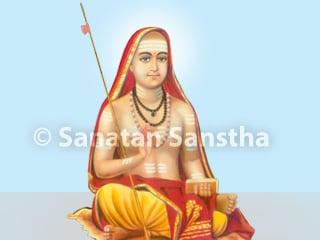
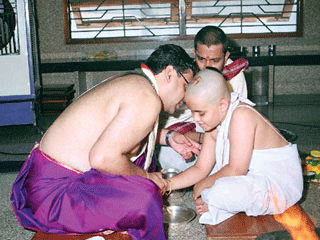 How does the system of stages of life help in attaining four pursuits?
How does the system of stages of life help in attaining four pursuits?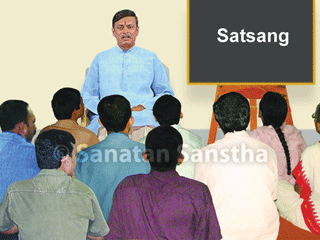 Why is humility a mandatory attribute for Brahman class?
Why is humility a mandatory attribute for Brahman class?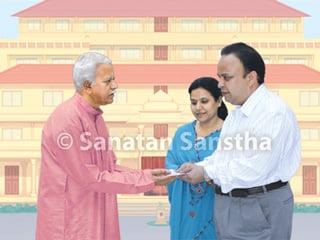 To whom should the offering be made?
To whom should the offering be made?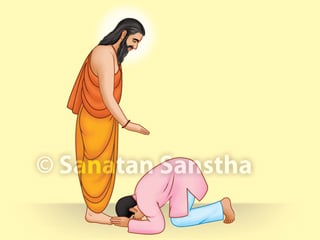 How is the 'class' (varna) of an individual determined?
How is the 'class' (varna) of an individual determined?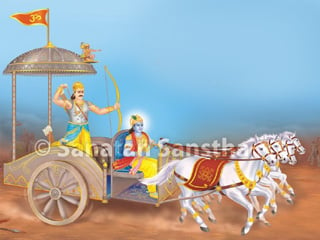 How did decline in righteousness cause creation of four classes?
How did decline in righteousness cause creation of four classes?